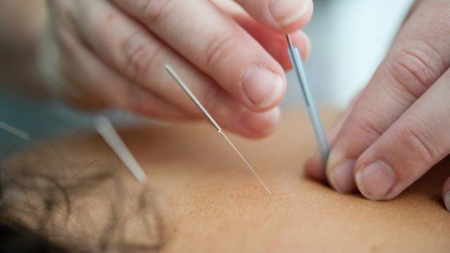- Joined
- Jun 11, 2022
- Messages
- 215,110
- Reaction score
- 1
- Points
- 38

Published 12/2022MP4 | Video: h264, 1280x720 | Audio: AAC, 44.1 KHzLanguage: English | Size: 1.19 GB | Duration: 1h 49m
A short course on providing effective dry needling on patients with shoulder issues.
What you'll learn
The guidelines, contraindications and complications of dry needling
How to diagnose a trigger point
What are the effects of dry needling
Demonstration of every type of dry needling technique for the shoulder
Demonstration of a taping method combined with dry needling for the shoulder
Requirements
Some knowledge of anatomy and physiology is necessary.
Health professionals
Description
Dry needling is a treatment approach that has hovered in the shadows of alternative medicine for decades. Its genesis dates back to 1979, when it was introduced by Czech doctor Karel Lewit for myofascial pain relief. The technique was further explored by Travell and Simons in the 1990s. In recent years, dry needling has been getting a closer look as an inexpensive and minimally invasive alternative therapy for resolving pain and motor dysfunction. Trigger-point dry needling is an invasive procedure where an acupuncture needle is inserted into the skin and muscle. It is aimed at myofascial trigger points (MTrP) which are hyperirritable spots in skeletal muscle that are associated with a hypersensitive palpable nodule in a taut band. Trigger point dry needling can be carried out at superficial or deep tissue level. Dry needling is used by thousands of physiotherapists worldwide. In many countries, it is within the professional and legal scope of physiotherapy practice since decades. This particular course is inspired and based on David G. Simons Academy (DGSA) with bits from specific applications that come with experience. DGSA teach dry needling since the early 90s, with courses that recognize and respect the internationally recognized Swiss Guidelines For Safe Dry Needling, published by the Dry Needling Association Switzerland, DVS. The dry needling courses are intended for physiotherapists, medical doctors, chiropractors and osteopaths. In this course, you'll learn: Guidelines, precautions, contraindications, complications of dry needlingDiagnosis of trigger points and effects of dry needlingDemonstration of every type (static, dynamic, static electric, dynamic electric) of dry needling technique for the shoulderDemonstration of a taping method combined with dry needling for the shoulder Dry needling can rapidly get to the root of muscle dysfunction. In the case of myofascial trigger points in the rotator cuff of the shoulder, dry needling is the most effective method for treating frozen shoulder syndrome. Dry needling is the preferred personalized monotherapy for pain relief and the prevention of trigger point relapse. Dry needling is a treatment modality that is minimally invasive, cheap, easy to learn with appropriate training, carries a low risk and its effectiveness has been confirmed in numerous studies. Dry needling treats muscle tissue, and its goal is to reduce pain, inactivate trigger points and restore function. At the moment, the muscles that this particular course focuses on are:SupraspinatusInfraspinatusSubscapularisTeres majorThe trapsDeltoidRhompoidLevator scapulae It's important to note that dry needling is not the same as acupuncture. It uses similar tools, but that's where the similarities end. Dry needling is performed by different practitioners with different training. Acupuncture is based on Eastern medicine, while dry needling is rooted in Western medicine and evaluation of pain patterns, posture, movement impairments, function and orthopedic tests. Dry needling zeros in on myofascial trigger points to evoke a physiological response, while the ancient practice of acupuncture works with the body's energy meridians, or chi, to restore balance.
Overview
Section 1: Introduction
Lecture 1 Introduction
Section 2: Theory
Lecture 2 Trigger points
Lecture 3 Diagnosis of trigger points
Lecture 4 Types of dry needling
Lecture 5 Guidelines
Lecture 6 Contraindications & implications
Lecture 7 Accidental needle prick
Lecture 8 Before applying
Lecture 9 Physiological effects of dry needling
Section 3: Action
Lecture 10 Superficial dry needling the shoulder
Lecture 11 Infraspinatus
Lecture 12 Supraspinatus
Lecture 13 Teres major
Lecture 14 Subscapularis
Lecture 15 Deltoid
Lecture 16 The traps
Lecture 17 Rhompoid
Lecture 18 Levator scapulae
Lecture 19 Static electric dry needling of the shoulder
Lecture 20 Kinesiotaping + dry needling for the shoulder
Section 4: Conclusion
Lecture 21 Conclusion
Physiotherapists starting to integrate dry needling into their practice looking for direction and mentorship with regards to the shoulder,Physicians treating patients with myofascial pain at the shoulder,For those who have no experience in dry needling, this course provides adequate knowledge about the training and clinical reasoning in practising needling on the shoulder,For professionals with knowledge in dry needling, you may find some new ideas on several alternative dry needling techniques on the shoulder,Health professionals
HomePage:
Code:
https://www.udemy.com/course/dry-needling-the-shoulder/DOWNLOAD
Code:
https://1dl.net/ogw8ihtg3fpt/3HE6axk0__Dry_needli.part1.rar
https://1dl.net/px4zut4r5oox/3HE6axk0__Dry_needli.part2.rarFeel free to post your Dry Needling The Shoulder. Free Download, torrent, subtitles, free download, quality, NFO, Dangerous Dry Needling The Shoulder. Torrent Download, free premium downloads movie, game, mp3 download, crack, serial, keygen.







